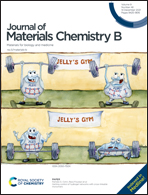A lipid droplet specific fluorescent probe for image-guided photodynamic therapy under hypoxia†
Abstract
Photodynamic therapy (PDT) is a potential strategy for many superficial, esophageal, intestinal, and bronchial cancer treatments, but its therapeutic effect is limited by a lack of specificity and the hypoxic tumor environment. It is necessary to develop novel photosensitizers (Ps) with organelles targeting and the ability to generate cytotoxic species under light irradiation without the presence of oxygen. Herein, we designed and synthesized a biocompatible fluorescent Ps CPNBD for lipid droplets (LDs) fluorescence (FL) image-guided PDT. CPNBD showed FL quenching in water but FL was significantly turned on by oil with a remarkable FL enhancement compared to that in aqueous solution. Due to its strong lipophilicity (Clog P of 7.96), CPNBD could specifically stain the LDs of human clear cell renal cell carcinoma (ccRCC) tumor cells and tissues with good photostability. Meanwhile, CPNBD could efficiently generate cytotoxic reactive oxygen species under low-power white-light irradiation, which could efficiently damage DNA via a PDT process with great tumor suppression ability in vitro and in vivo. Thus, this work provides a novel strategy for designing LD-targeting Ps with efficient image-guided PDT under the tumor hypoxic environment.



 Please wait while we load your content...
Please wait while we load your content...